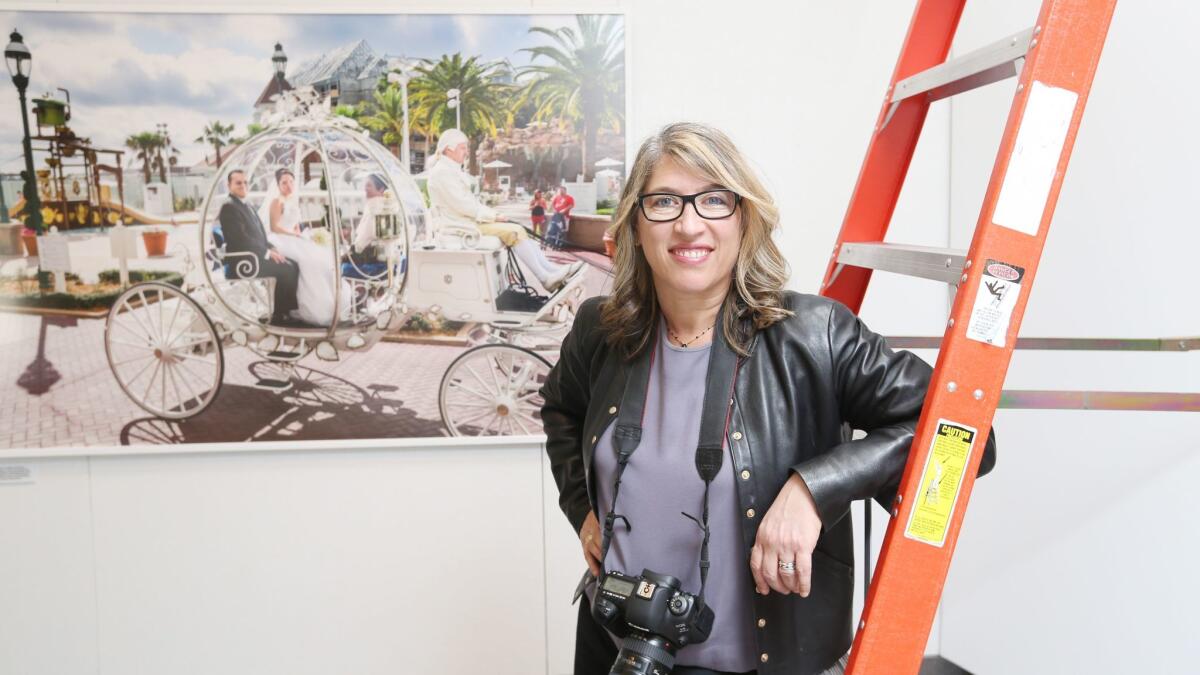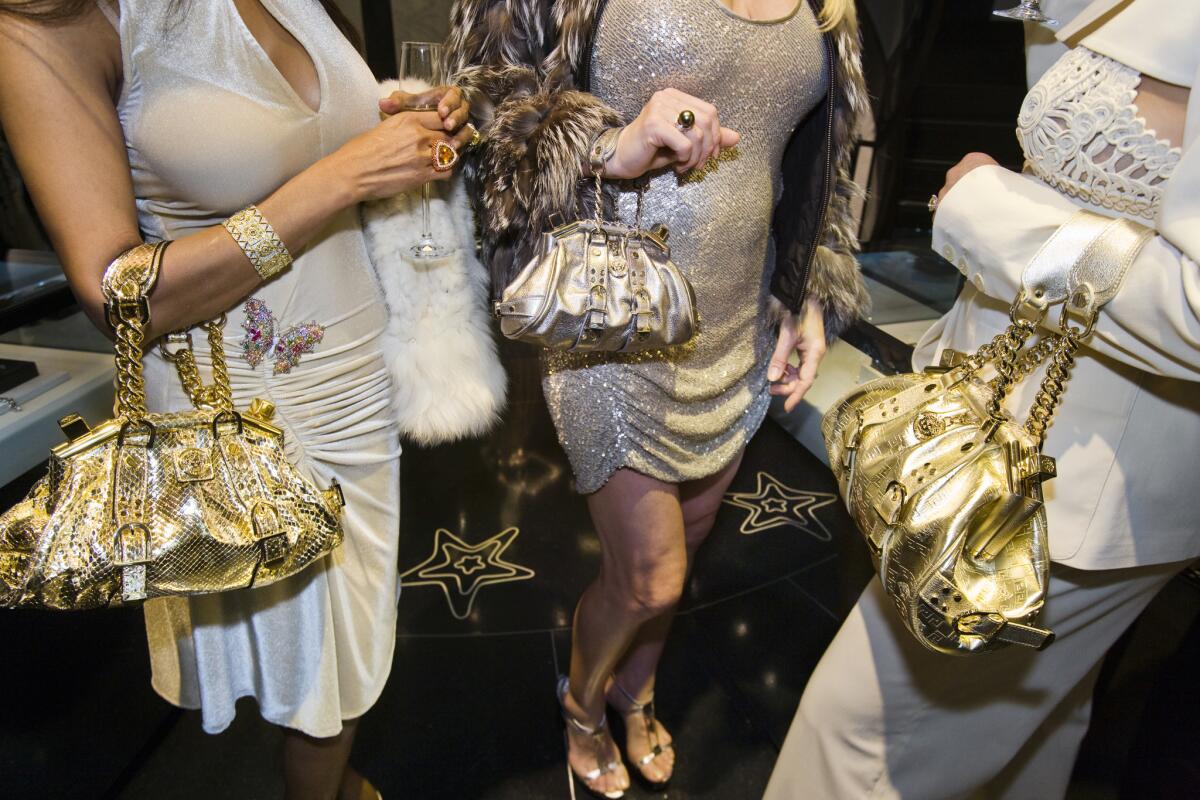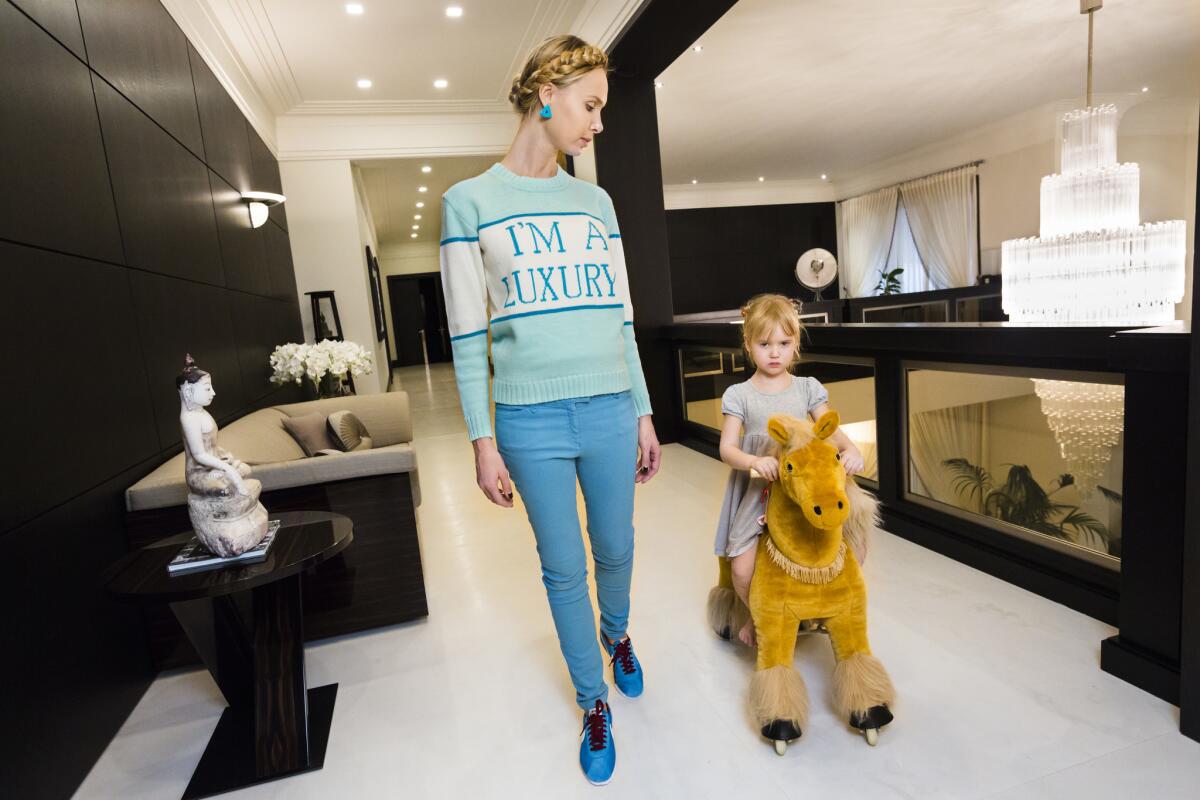America exports its addiction to bling across the globe; Lauren Greenfield captures it with her camera

- Share via
Lauren Greenfield recently stopped at Target with her 10-year-old son. The idea was to grab a coffee and use the restroom. Before she knew it, she had a cart full of stuff, including a $50 jar of anti-aging face cream. Her son made her put it back.
Greenfield tells the story while sitting on a couch inside the Annenberg Space for Photography in L.A. days before the opening of her solo show, “Generation Wealth,” which runs through Aug. 13. She wears studious black-framed glasses, a black jacket and a breezy lavender blouse, looking very much out of step with the gold-plated luxury in the frames around her.

Greenfield has devoted the last 25 years to documenting the hollow promise of rampant consumer culture and what she calls “the influence of affluence.” The point of her Target anecdote: If someone like her still falls prey to the carefully engineered impulse to buy, buy, buy, imagine how vulnerable the rest of us are.
“I’ve always been inspired by my own urges,” says Greenfield, sipping on a large coffee. “If you go into a department store, you’re going to want stuff. I hope people come to this exhibit and see themselves. I hope they don’t say, ‘Who are these people?’ ”
The people in the 195 prints on display represent seemingly every rung on the socio-economic ladder. They are strippers in Magic City, a club in Atlanta; teens getting a nose job in Hollywood; A-list celebrities partying in Beverly Hills; 6-year-old beauty pageant stars in Oxnard; kids doing sexy dances at fat camp in the Catskills; the new rich in China and Russia; families across the U.S. and Ireland that lost everything in the financial crash of 2008; and much more.
Across the board, people wanted to be rich, and [they] have this new concept of the American Dream, and the easy credit of the boom allowed them to do it.
— Lauren Greenfield
The exhibit, which is complemented by a 500-page book featuring 650 images and 150 first-person interviews, is an anthropological deep-dive into the way the very idea of wealth has infected the human psyche globally. The effect, according to Greenfield’s lens, has been largely deleterious. The richly colored photos capture images of excess that often tip into the obscene.

“Generation Wealth” can certainly be taken as a cultural critique, but Greenfield says she is documenting, not judging. The people in her photos are making rational choices, given the values of the culture, she says. She has frozen the moments that pull back the curtain on the profound influence of celebrity, mass media and materialism.
What viewers might find uncomfortable is not just the grotesque nature of materialist impulses, but rather that those same impulses are very much at play in their own lives. The shock of self recognition provides a visceral jolt.
“Her work is timely, her work is relevant, she has an extraordinary eye,” says Cinny Kennard, executive director of the Annenberg Foundation, which opened the space in 2009. “She was prescient 25 years ago. This storytelling started in her hometown and … then she goes on to capture it around the world.”
Greenfield first began exploring the themes that would define “Generation Wealth” in the late 1990s with a series of photos called “Fast Forward: Growing up in the Shadow of Hollywood.” Her images of teens doing speed off toilet paper dispensers at school, partying at clubs like the Whisky a Go Go and eating pizza in the back of stretch limos grabbed the popular imagination and launched Greenfield’s career as a documentary photographer.
She followed “Fast Forward” with the 2002 monograph “Girl Culture,” which examined the myth of beauty and the menace presented by pop culture to girls. In 2012, she made her name as a documentary filmmaker with “The Queen of Versailles,” about David and Jackie Siegel, who live in one of the largest and most expensive single-family homes in the country.

The financial crash of 2008, which wreaked havoc on the Siegels, sowed the seeds of “Generation Wealth.” Greenfield would eventually gather a quarter-century’s worth of photojournalism and filmmaking under a single umbrella.
“That’s when it clicked that everyone had been driven by the same goals and made the same mistakes,” Greenfield says. “Across the board, people wanted to be rich, and [they] have this new concept of the American Dream, and the easy credit of the boom allowed them to do it.”
Add the long shadow of Hollywood, with its uncanny ability to export garish values globally, and you have the media-fueled fantasy of wealth that sprang to life in the ’80s and ’90s — “everyone blinging out and going into debt,” Greenfield says.
Fake it till you make it — that’s the ethos of many of Greenfield’s subjects, for whom the perception of being wealthy is just as important as actually being wealthy. For most, when wealth never comes, life simply becomes a charade.
The crash turned the whole thing into a morality tale, Greenfield says, only we didn’t learn. We got up, dusted ourselves off and began the cycle all over again. Now, however, we are living in an era defined by increasing economic inequality and decreasing social mobility, so the denouement of this second act remains to be seen, she says.
“She is one of the greats in terms of taking her artistry and documentary and weaving a story of the times we’re living in to provoke conversation and thought,” says Kennard, who was a foreign correspondent in the 1990s. “She is operating almost like a journalist. She knew this story was moving to Iceland and Ireland and China. That is a real skill set, that’s almost something you can’t learn.”
Greenfield’s drive to tell the full story of what she found during the course of her travels at home and abroad turned the creation of “Generation Wealth” into a full-time job. In the last four years, she has culled through more than 500,000 photos from her archives. Writing the text that resulted from the extensive interviews she conducted took more than a year between herself and another editor.
The text of 42 of those interviews is featured in the Annenberg exhibit. Greenfield collaborated with architects Sharon Johnston and Mark Lee to create a space that gives equal weight to text and images, with the edited interviews framed between rows of photos.
“There’s a lot of reading in the show,” Greenfield says. “You don’t have to read every interview to get it, but if you want to know more about that person and the underlying ideas, you can dig deeper.”
If you do, you’ll discover the 31-year-old bus driver from Centreville, Va., who traveled to Brazil to have a slew of plastic surgeries performed all at once. She had a tummy tuck, a breast lift, a nose job, liposuction and a butt lift with the hope of being a better mother to her young daughter, she said.
“I came to the conclusion that satisfying my own body issues was the best thing I could do for her. She knew very much the parts of my body that were disfigured, and she was about to enter an age where her own body would change rapidly,” reads the text accompanying pictures of a woman named Cathy. “She had a lot ahead of her, and I wanted to get the emphasis off of me and what I was unhappy with.”
The interviews shed light on the fragile lives within each photo. Every story is a data point in the bigger picture, Greenfield says. With that Greenfield hopes to say, “If we stay on this road, it’s unsustainable. It’s unsustainable environmentally, it’s unsustainable morally, it’s unsustainable for communities and families. … It doesn’t lead to satisfaction. It’s a culture of addiction.”
Nobody is above this, not even Greenfield. Given the chance, she says, she’ll still reach for pricey packaging and the promise of youth in a bottle at Target.
♦ ♦ ♦ ♦ ♦ ♦ ♦ ♦ ♦ ♦
‘Generation Wealth’ by Lauren Greenfield
Where: Annenberg Space for Photography, 2000 Avenue of the Stars, Los Angeles
When: Through Aug. 13, closed Mondays and Tuesdays
Info: (213) 403-3000, www.annenbergphotospace.org
ALSO:
Auction battles and encounters with royalty: LACMA curator looks back at 24 years of adventures
With bold brush strokes and luminous neon, L.A. painter Mary Weatherford comes into her own
Doug Aitken's 'Mirage': a funhouse mirror for the age of social media
100 missing women: Drawings at African American museum tell a powerful story of loss
The biggest entertainment stories
Get our big stories about Hollywood, film, television, music, arts, culture and more right in your inbox as soon as they publish.
You may occasionally receive promotional content from the Los Angeles Times.








